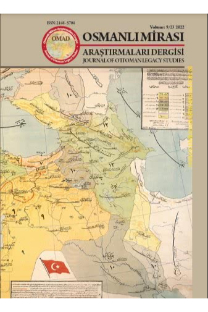THE OTTOMAN RESPONSE TO MISSIONARY ACTIVITIES OF IRANIAN SHIITE ULEMA: THE CASE OF IRAQ IN THE NINETEENTH CENTURY
İranlı Şii Ulemanın Misyonerlik Faaliyetlerine Osmanlı Tepkisi: On Dokuzuncu Yüzyılda Irak Örneği
___
Ottoman Archives (Osmanlı Arşivi), BOA:Babıali Evrak Odası (BEO), no: 413/ 30919, 401/ 30073.
Dahiliye Mektubi Kalemi (DH.MKT.), no: 2394/ 21.
Hariciye Nezareti İstişare Odası (HR.HMŞ. İŞO.), no: 136/ 12.
İrade Hariciye (İ.HR.), no: 78/ 3847.
İrade Maliye (İ.ML.), no: 10/ 61.
Maarif Nezareti Mektubi Kalemi (MF. MKT.), no: 561/ 28, 1050/ 7.
Sadaret Umum Vilayet Evrakı (A.MKT.UM.), no: 549/ 27.
Şura-yı Devlet (ŞD.), no: 2488/ 28.
Yıldız Esas Evrakı (Y.E.E.), no: 9/ 14.
Yıldız Yaveran ve Maiyyet-i Seniyye Erkan-ı Harbiye Dairesi (Y.PRK. MYD.), no: 23/ 18
Takvim-i Vekayi, 6 Safer 1263/ 24 January 1847.
Ateş, Sabri. (2010). “Bones of Contention: Corpse Traffic and Ottoman-Iranian Rivalry in Nineteenth Century Iraq.” Comparative Studies of South Asia, Africa and the Middle East 30, no. 3, pp. 512-32.
Bektaş, Erhan. “The Tanzimat State in the Ottoman Iraq: Tribes, Ideology/Shiism and Taxation, 1830-1910.” The Atatürk Institute for Modern Turkish History of Boğaziçi University, MA Thesis, 2015.
Cole, Juan R. I. and Moojan Momen. (August 1986). “Mafia, Mob and Shiism in Iraq: The Rebellion of Ottoman Karbala 1824-1843,” Past & Present, no. 112, pp. 112-43.
Cole, R. I. Juan. (Dec 2006). “Indian Money and the Shi’i Shrine Cities of Iraq, 1786-1850.” Middle Eastern Studies 22, no. 4, pp. 461-80.
Çetinsaya, Gökhan. Ottoman Administration of Iraq: 1890-1908. London: Soas/Routledge Studies on the Middle East, 2006.
Deringil, Selim. (1990). “The Struggle against Shiism in Hamidian Iraq: A Study in Ottoman Counter- Propoganda”, Die Welt des Islami New Series 30, no. 4, pp. 45-62. Fattah, Hala. A Brief History of Iraq. New York: Infobase Publishing, 2009.
Hathaway, Jane. The Arab Lands Under Ottoman Rule, 1516-1800. New York: Pearson Longman, 2008.
Issawi, Charles. The Economic History of the Middle East 1800-1914. Chicago: The University of Chicago Press, 1966.
Keddie, Nikki. Religion and Politics in Iran: Shiism from Quietism to Revolution. New Heaven: Yale University Press, 1983.
Kern, M. Karen. Imperial Citizen: Marriage and Citizenship in the Ottoman Frontier Provinces of Iraq. New York: Syracuze University Press, 2011.
Nakash, Yitzhak. The Shiis of Iraq. New Jersey: Princeton University Press, 2003.
Yaslıçimen, Faruk. (2016). Saving the Minds and Loyalties of Subjects: Ottoman Education Policy Against the Spread of Shiism in Iraq during the Time of Abdülhamid II. Divan: Disiplinlerarası Çalışmalar Dergisi 21 (4), pp. 63-108.
Algar, Hamid. “Atabat.” in Encyclopaedia Iranica, http://www.iranicaonline.org/articles/atabat (accessed 10 May 2010).
- ISSN: 2148-5704
- Yayın Aralığı: 3
- Başlangıç: 2014
- Yayıncı: Abidin Temizer
AKSARAYLI HASAN RIZÂÎ’NİN SAD-KELİME-İ ALÎ TERCÜMESİ
ELITE EDUCATION AT THE OTTOMAN COURT FOR HIGHER BUREAUCRACY
II. ABDÜLHAMİD İMARI KARESİ İDADİ VE SULTANİSİNİN MİMARİ ANALİZİ VE RESTORASYON ÖNERİLERİ
İranlı Şii Ulemanın Misyonerlik Faaliyetlerine Osmanlı Tepkisi: On Dokuzuncu Yüzyılda Irak Örneği
Yüksek Bürokrasi İçin Osmanlı Sarayında Elit Eğitimi
Romen Ülkelerinde Göçle Gelen Kültürel Etkileşim: Osmanlı Ürünleri ve Sosyal Değişim
ÂSAFÎ DAL MEHMED ÇELEBİ’NİN ŞECÂ’AT-NÂME’SİNDE EDEBÎ TASVİRLER
DİVAN ŞAİRİNİN İMGELEM DÜNYASINDAN BİR ÖRNEK: FÜLFÜL
YUSUF FRANKO’S CARICATURES UNDER THE CONCEPTUAL BLENDING MAGNIFYING GLASS
